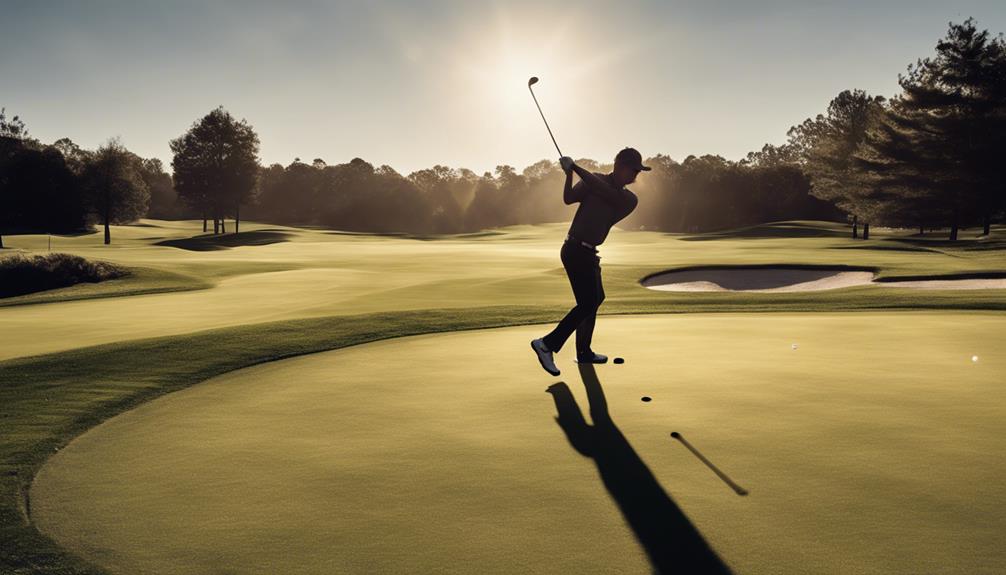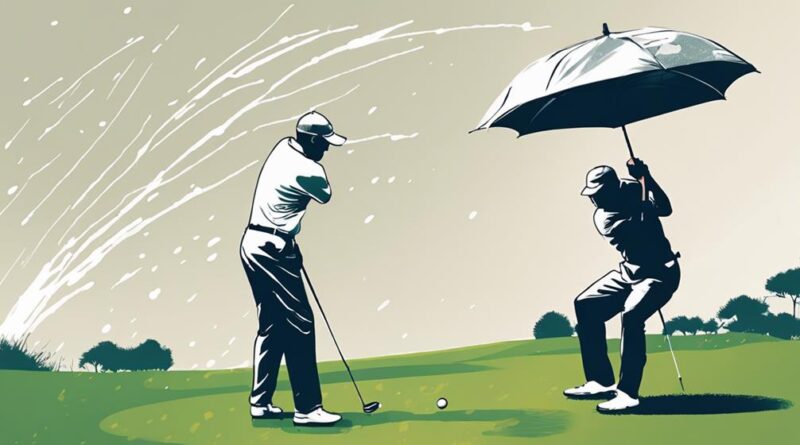Top 3 Ways Weather Influences Your Golf Game
When you play golf, weather impacts your game in key ways. Wind alters shots, affecting trajectory and distance. Pick clubs wisely to combat its effects. Tailor club choice to wind direction and strength for better control. Rain hampers putting accuracy, needing stable stance and grip adjustments. Regulate touch due to altered green speed in rainy conditions. Sunlight influences ball flight, affecting trajectory and distance. Utilize shadow angles for alignment cues but beware of glare affecting ball tracking. Understanding sunlight assists in gauging elevation changes. Uncover more ways weather shapes your golf game by considering these three factors.
Impact of Wind on Golf Shots
When playing golf, the wind significantly affects the trajectory and distance of your shots, requiring careful consideration and adjustments to achieve optimal performance. Club selection plays a crucial role in combating the wind's influence on your shots. Choosing the right club based on the wind direction and speed can help you control the ball's flight path effectively. For instance, when facing a headwind, selecting a club with more loft can help the ball rise higher and travel a longer distance, compensating for the wind's resistance. On the other hand, in a tailwind situation, opting for a lower lofted club can prevent the ball from ballooning and ensure a more accurate shot trajectory towards the target.
Understanding how the wind affects shot trajectory is essential for golfers aiming to enhance their game. Crosswinds can be particularly challenging as they can cause the ball to drift off course. To counter this, adjusting your aim and club selection to allow for the wind's influence is key. For example, when hitting against a left-to-right crosswind, aiming slightly left of the target and using a club with more forgiveness can help counteract the wind's push and keep your shot on track.
Effect of Rain on Putting Accuracy
The influence of weather conditions extends beyond wind to impact your golf game, with rain significantly affecting putting accuracy. When rain starts to fall on the golf course, the greens become slick and challenging to read. Your putting technique plays a crucial role in these conditions. To adapt, focus on maintaining a stable stance and a consistent stroke. Adjust your grip pressure to ensure a firm hold on the club without tensing up too much, as this can lead to missed putts.
Rain can also alter the speed of the greens, requiring you to recalibrate your touch. Consider the break of the putt and how the wet surface might affect its path. Be prepared to adjust your aim and power accordingly. Your ability to read the greens becomes paramount when rain is in play. Keep in mind that the ball may not roll as smoothly as it would on a sunny day.
Incorporating a more aggressive approach with your putting can help counteract the challenges posed by rain. By confidently striking the ball and trusting your adjustments, you can enhance your putting accuracy even in adverse weather conditions. Remember, mastering the art of putting in the rain is a valuable skill that can set you apart on the course.
Influence of Sunlight on Ball Flight

Sunlight's angle and intensity significantly influence the trajectory and distance of your golf ball's flight. The position of the sun in the sky affects the shadow angles you perceive, providing cues for alignment and aim. When hitting the ball, consider how your shadow aligns with the target line; this can help you visualize the desired path of the ball. Furthermore, the sun's glare can impact your ability to track the ball in flight. To mitigate this, you may need to adjust your positioning or use sunglasses to reduce glare.
Understanding shadow angles is crucial for gauging the elevation changes on the course. When the sun is lower in the sky, shadows are elongated, making it easier to perceive undulations on the greens or fairways. This knowledge can guide your club selection and shot strategy, aiding in more accurate and precise shots. Additionally, being aware of how the sun's position affects your own shadow can help you maintain proper posture and alignment throughout your swing.
Sun glare, while potentially hindering visibility, can also be used to your advantage. By observing how the sunlight reflects off water hazards or sand traps, you can assess distances more effectively. Embrace the sun's presence on the course by leveraging shadow angles and managing sun glare to enhance your overall golf performance.
Frequently Asked Questions
How Does Humidity Affect Golf Club Grip?
In humid weather, your golf club grips may become slippery due to sweat, affecting your swing. Rainy conditions exacerbate this issue, making it harder to maintain a secure hold on the club.
To counteract this, consider using gloves or towels to keep your hands dry. Additionally, you may need to adjust your swing technique to accommodate the potential slipperiness of the grips, ensuring a more controlled and effective shot.
Can Lightning Impact a Golfer's Performance?
When considering lightning safety on the golf course, it's vital to recognize its potential impact on your performance. Beyond the physical danger, the mental game can suffer from the distraction and anxiety that lightning strikes bring.
Your focus and concentration may waver, affecting your ability to make precise shots. Being aware of the risks and having a plan in place for lightning safety can help you maintain your performance despite the external factors.
Does Fog Decrease Visibility on the Course?
When playing in foggy conditions, visibility on the course decreases significantly. This can make it challenging to accurately judge distances and choose the right clubs. Golfers often have to make swing adjustments to compensate for the reduced visibility and navigate foggy hazards strategically.
What Role Does Temperature Play in Ball Compression?
When it comes to ball compression in golf, temperature is a critical factor. Lower temperatures can cause the golf ball to become denser, resulting in decreased compression upon impact. This can affect your swing mechanics and the overall performance of your equipment.
To counter this, adjusting your club selection and swing speed can help optimize your game in varying weather conditions. Proper equipment maintenance is also key to ensuring consistent performance on the course.
Are There Specific UV Risks for Golfers on Sunny Days?
On sunny days, UV rays pose risks to golfers. UV protection is crucial for sun safety on the course.
Excessive sun exposure can lead to skin damage, premature aging, and even skin cancer. Wearing protective clothing, sunscreen, and sunglasses with UV protection are essential measures to reduce the harmful effects of UV radiation.
Golfers must prioritize UV safety to enjoy the game while safeguarding their skin health.
Conclusion
In conclusion, weather plays a crucial role in determining the outcome of your golf game. The wind can significantly alter the trajectory of your shots, rain can affect putting accuracy, and sunlight can influence the flight of the ball.
Understanding how these weather conditions impact your game can help you make strategic adjustments and improve your overall performance on the golf course. Be prepared for any weather conditions and adapt your game accordingly to optimize your chances of success.
